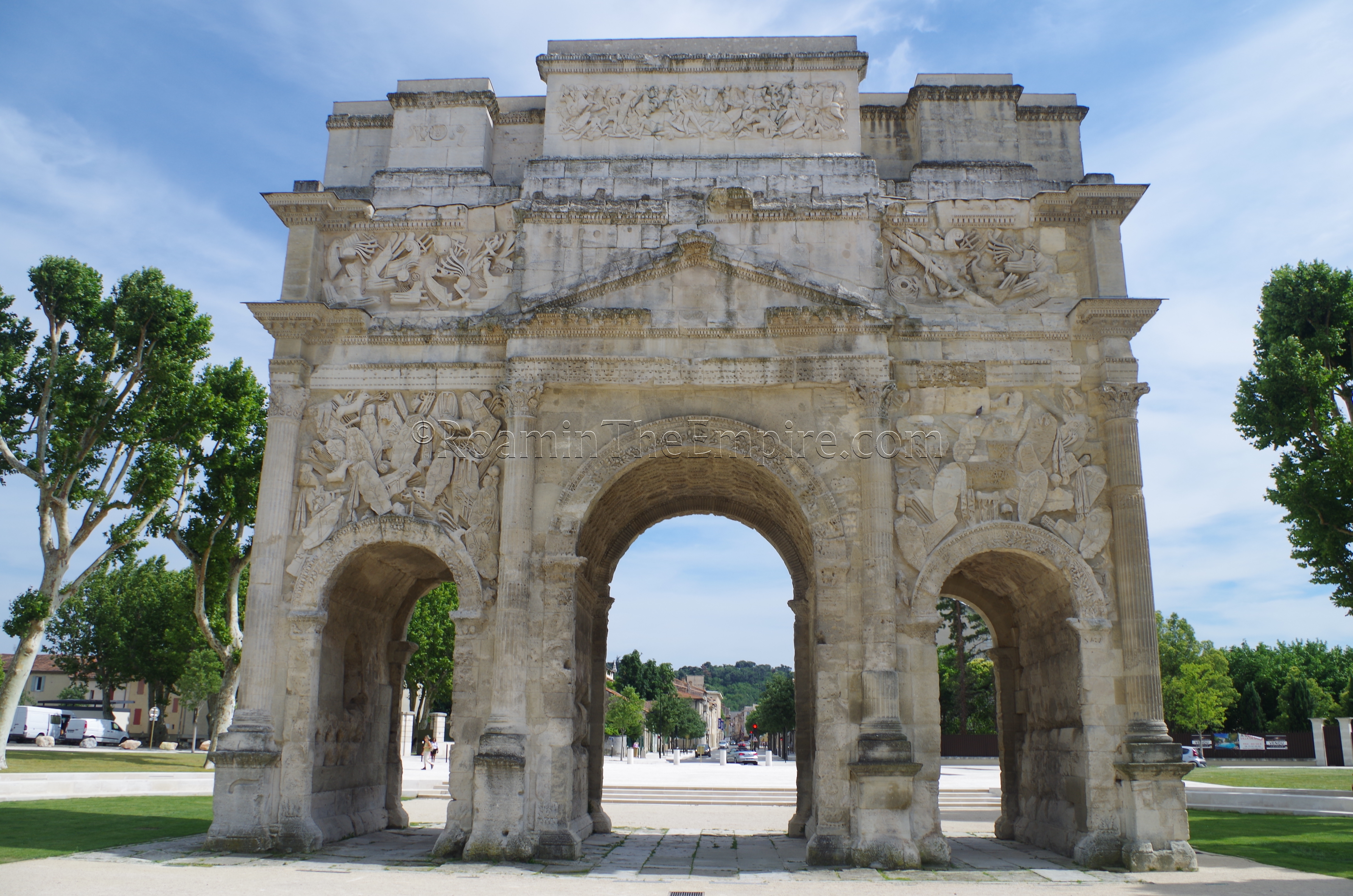
Most Recent Visit: June 2018
Not far from the confluence of the Rhône and L’Aigue rivers is the French town of Orange, which boasts perhaps two of the most well-known Roman monuments in France; the UNESCO World Heritage Sites of the Théâtre Antique d’Orange and the Arc de Triomphe d’Orange. Located in the territory of the Cavari prior to Roman conquest, a Gallic settlement called Arausio, named after a local water deity of the same name, was located on or near the site of present-day Orange. The Cavari seem to have been allied with Massalia at the time of the initial Roman conquest of the area in 121 BCE, and as such did not come into direct conflict with the Romans at the time.
On October 6th, 105 BCE, amidst the Cimbrian War between the Romans and the migrating Germanic Cimbri and Teutoni tribes, a major battle was fought near Arausio. After a disastrous Roman defeat at the Battle of Noreia in 112 BCE, the Cimbri and Teutoni moved into Gallia Narbonensis in 109 BCE and handed the Romans another convincing defeat at the Battle of Burdigala in 107 BCE. In 105 BCE the consul Gnaeus Mallius Maximus and proconsul Quintus Servilius Caepio were given command of a large force of perhaps as many as 80,000 soldiers to field against the Germanic tribes. Disharmony between the two commanders led to a disagreement in the plan of action and the splitting of the force between the two, who made separate camps near Arausio. Despite Maximus entering into negotiations with the Germanic force, Caepio decided to make an attack with just his army, which was swiftly defeated by the Cimbri and Teutoni force. The Germanic tribes then fell upon Maximus’ camp and defeated them in similar fashion. Though the commanders and a handful of soldiers survived, most of the Roman force was slaughtered.
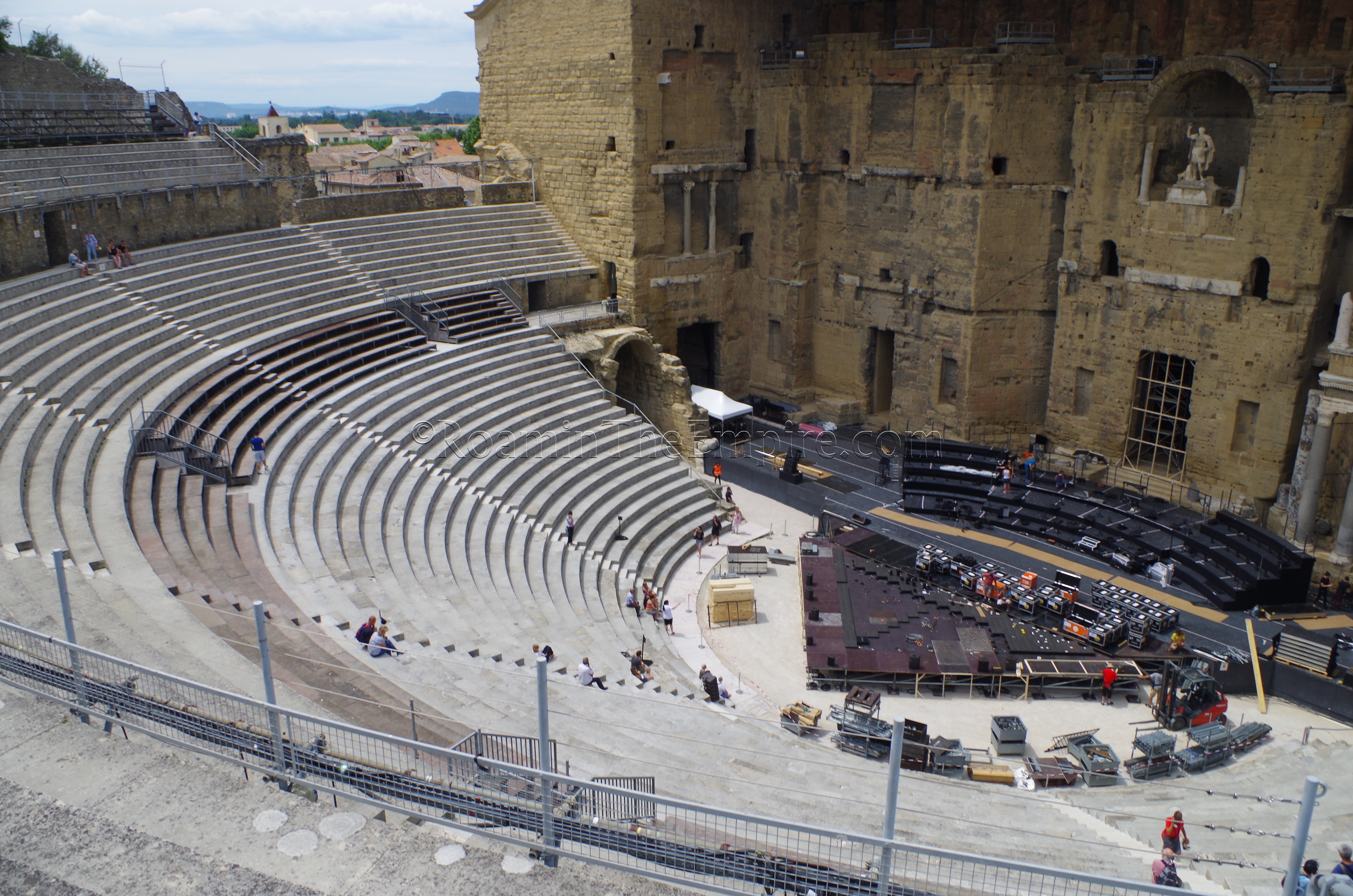
In 35 BCE, a colony of veterans from Legio II Gallica was established at Arausio by Octavian, and the name of the town was changed to Colonia Julia Firma Secundanorum Arausio. Though Arausio doesn’t seem to feature much in the historical record in the 1st and 2nd centuries CE, it seems to have been a relatively prosperous settlement, but like many others in the area was sent into decline in the 3rd century CE due to the incursions of Germanic tribes. At that time, Arausio likely suffered some damage or sacking, and in the following century was sacked again by the Visigoths before falling under their control.
Getting There:
Orange is a relatively large city in the region, and as such it has a train station that is well-served from other cities in the country. The closest major city with an airport is Marseille, and there are frequent daily departures from Marseille to Orange that take between about an hour and a half and three hours depending on the train, and range in price from about 20 to 30 Euros. There are even several daily departures from the airport to Orange, including a few direct trains, priced at 23 Euros. Orange, however, is not so large of a city that parking seemed to be a very big issue; there is ample parking outside the city center, some of it free, with a no more than 10 minute walk into the center. There is also free parking a little closer to the center, but this generally seems to fill up pretty quickly.
Arc de Triomphe d’Orange
In the north of the city, outside of the historic center a bit, is the Arc de Triomphe d’Orange, part of the UNESCO World Heritage Site along with the theater. The arch is situated by itself in a little park area enclosed by a diverted road that presumably originally ran beneath the arch, which was preserved as part of medieval fortifications. As such, there is no admission or entrance; the monument can be freely visited 24 hours a day, and is lit up at night.
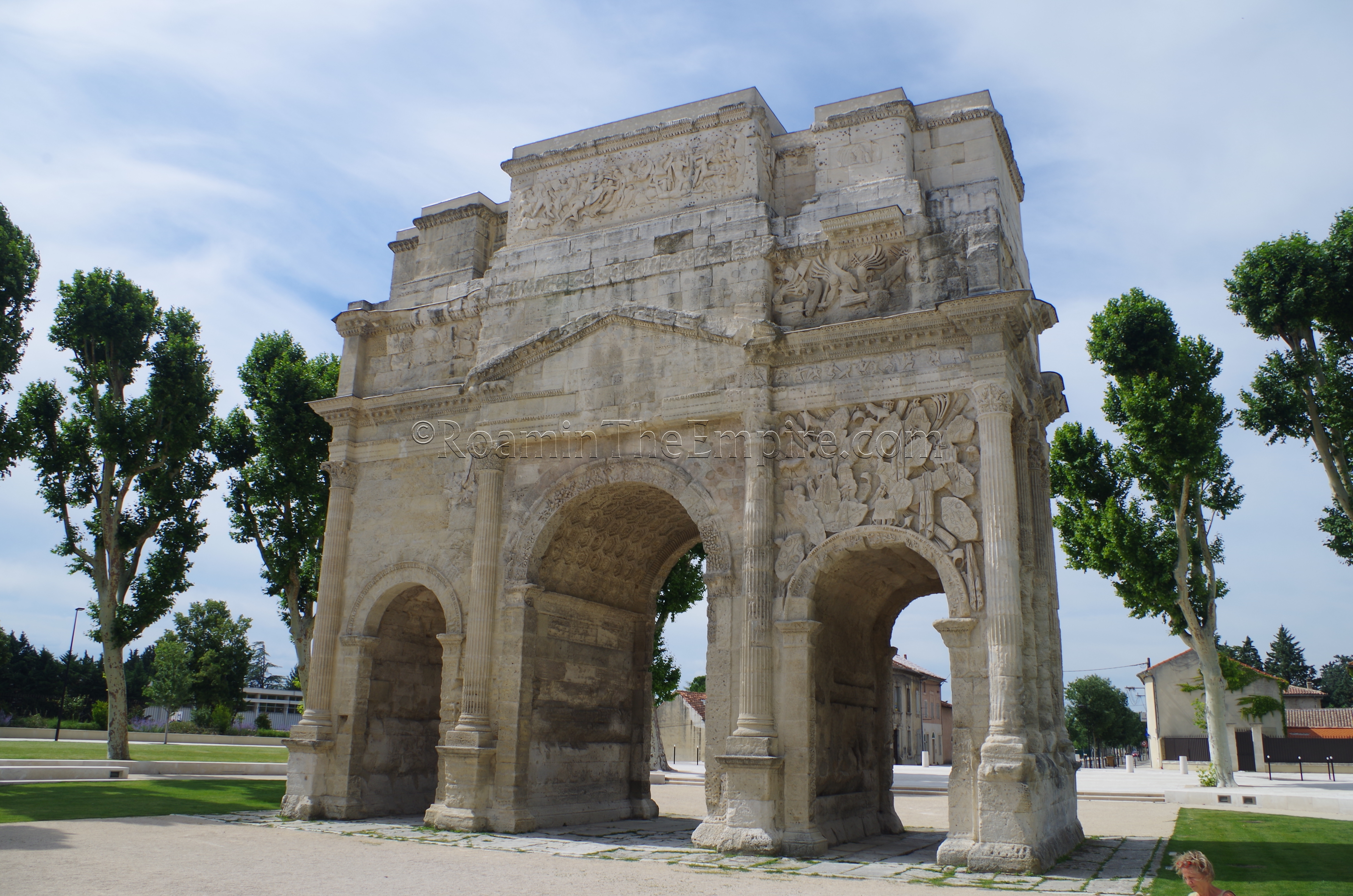
The exact nature and construction period of the arch is not completely clear, as there has not been a conclusive interpretation of the inscription, which remains only as clamp holes that were used to fasten the letters to the monument. It is generally accepted to have been constructed by either Augustus or Tiberius in the 20’s CE, perhaps just being restored by the latter. One reading of the inscription interprets one of the names as ‘Sacrovir’, which is the name given by Tacitus as one of the leading figures in a 21 CE revolt near Augustodunum (Atun), several hundred kilometers up the Rhône Valley. The quelling of the revolt was achieved in part by Legio II Augusta, which would have been the legion that the veteran colonists of Arausio were previously part of, and whose Capricorn logo appears on the arch as well. The presence of naval scenes on the monument detracts somewhat from the notion that it might be associated specifically with the victory over the revolt, but also could have originally been constructed as such, and later altered by Tiberius to include the victories of Germanicus over the Germanic tribes.
While some panels from the arch have been lost, what remains is mostly imagery of war spoils from terrestrial and naval battles, trophies, and prisoners. There are also battle scenes featuring both Germans and Gauls above the pediments on each side, as well as some smaller battle related scenes in the divisions of the main panels. Unfortunately, there are no informational panels located in the vicinity of the arch.
Not far from the arch, down a street just a few minutes’ walk east, are the remains of the substructure of an aqueduct. These have also been described as being related to the town wall of Arausio, but, the placement seems to be a bit further north than the projected Roman era walls. They could, of course, have been used in the later city walls that apparently also made use of the triumphal arch. These remains are located at a few points along the south side of Avenue Guillaume le Taciturne between Avenue de Champlain and Avenue Jean Moulin. They are incorporated into modern walls and houses, but are largely pretty distinguishable from later constructions.
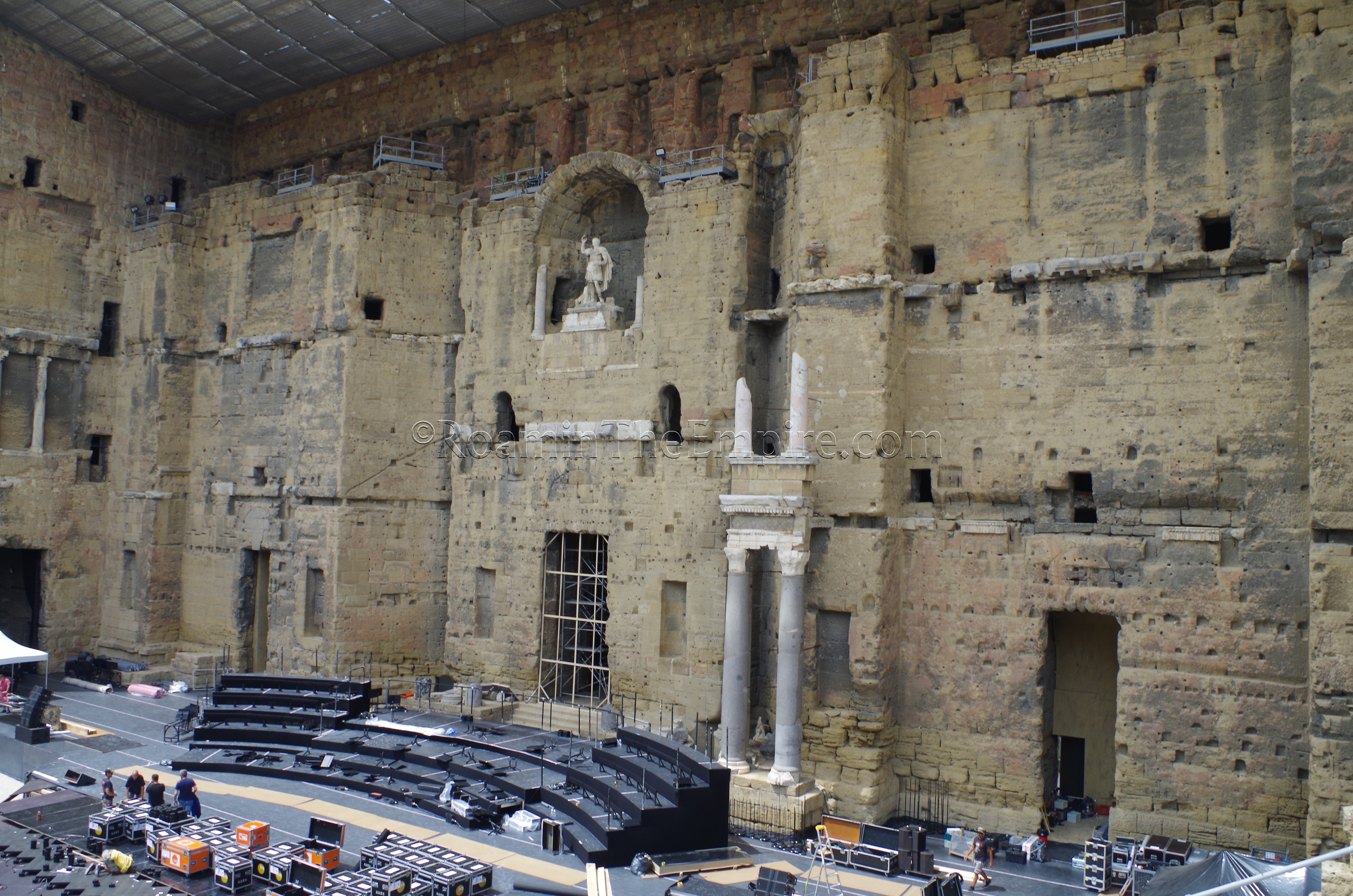
Théâtre Antique d’Orange
Heading south/southeast toward the historic center of Orange about a kilometer one reaches the other major monument remaining from Arausio, the Théâtre Antique d’Orange. Located at Rue Madeleine Roch 84, the theater is open daily. In January, February, November and December it is open from 9:30 to 16:30. In March and October it is open from 9:30 to 17:30 and in April and May from 9:00 to 18:00. From June to August it is open from 9:00 to 19:00. Frequent performances held at the theater during the summer impact the schedule somewhat, and so there are a number of days that the theater closes to visitors earlier than the posted times, and a schedule of these days can be found here. A combination ticket for the theater and the Musée d’Art et d’Histoire d’Orange, located just across the street is 9.50 Euros. Further, a combination ticket for these two attractions in Orange, as well as the amphitheater, Tour Magne, and Maison Carrée in Nîmes can also be purchased for 18.50 Euros and is valid for 30 days.
The theater itself is fairly impressive, often being counted among one of the best preserved Roman theaters in Europe. Built into the side of the Saint-Eutrope Hill, probably during the reign of Augustus, the theater uses the natural slope of the rock to help support the cavea, which are now heavily reconstructed to make use of the venue for modern performances. It is estimated that the theater likely held between 7,000 and 9,000 spectators. Perhaps most impressive is the external façade and the scaenae which have been preserved and reconstructed to a relatively complete state. There are a few informational signs in English and French (and sometimes German and/or Dutch) scattered around the theater.
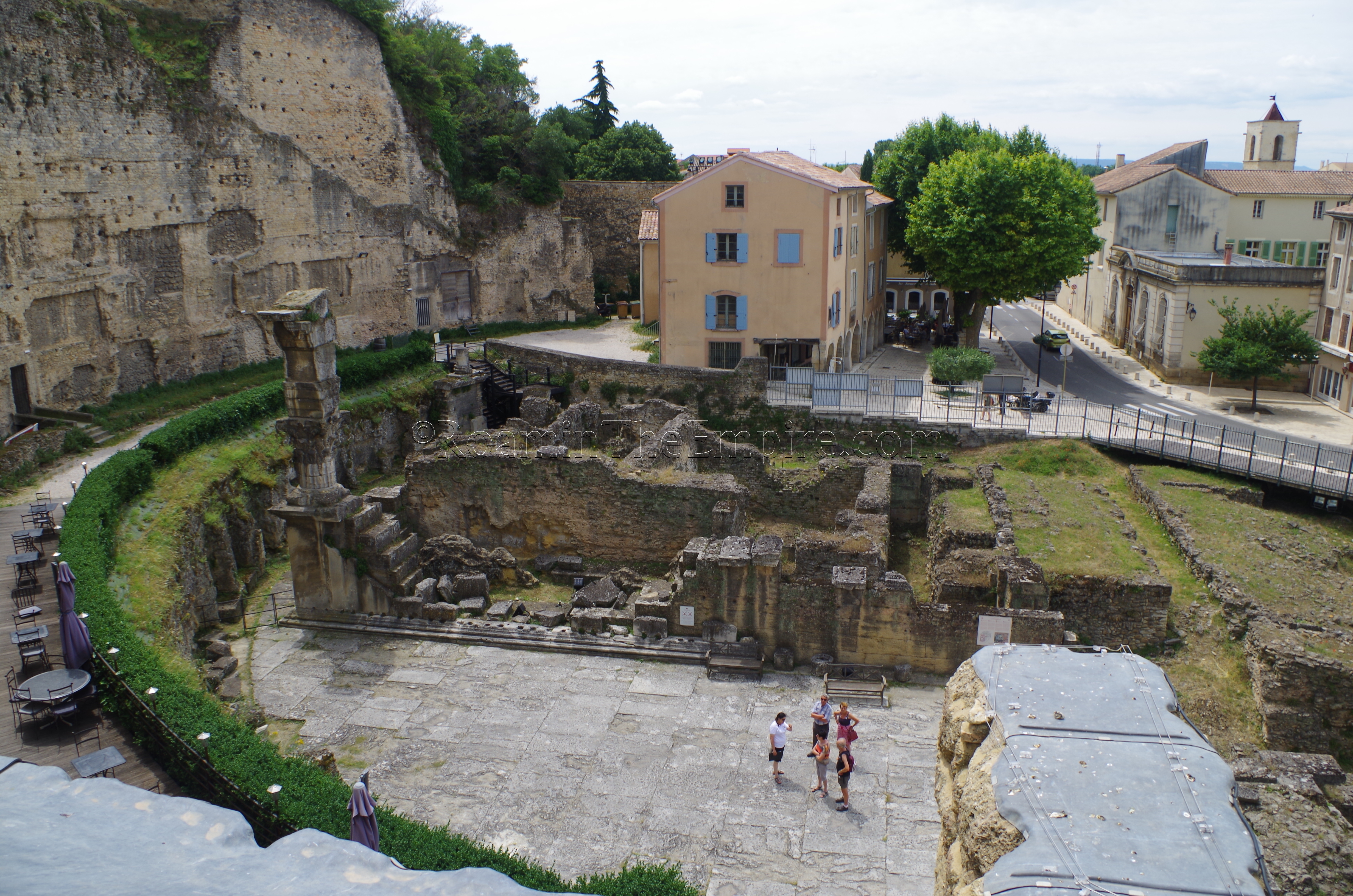
Adjacent to the theater, to the west, is a small area known as the hemicycle complex. The exact nature of this complex is not completely clear, but it is commonly thought to be associated with the imperial cult. An earlier construction on the site, perhaps dating back to the time of Augustus, may have been a nymphaeum, which may explain the semi-circular shape of the area. Later, possibly in the 2nd century CE, the area may have been repurposed to include a sanctuary and temple associated with the imperial cult.
Musée d’Art et d’Histoire d’Orange
Directly across the street from the entrance to the theater is the Musée d’Art et d’Histoire d’Orange. The ticket to the museum is included with access to the theater (and as far as I know, one cannot purchase a ticket to just one of the two for a cheaper price), and has generally the same opening times. The exceptions being that the museum is closed between 12:00 and 13:00 in January, February, November, and December and it opens 15 minutes later than the theater the rest of the year.
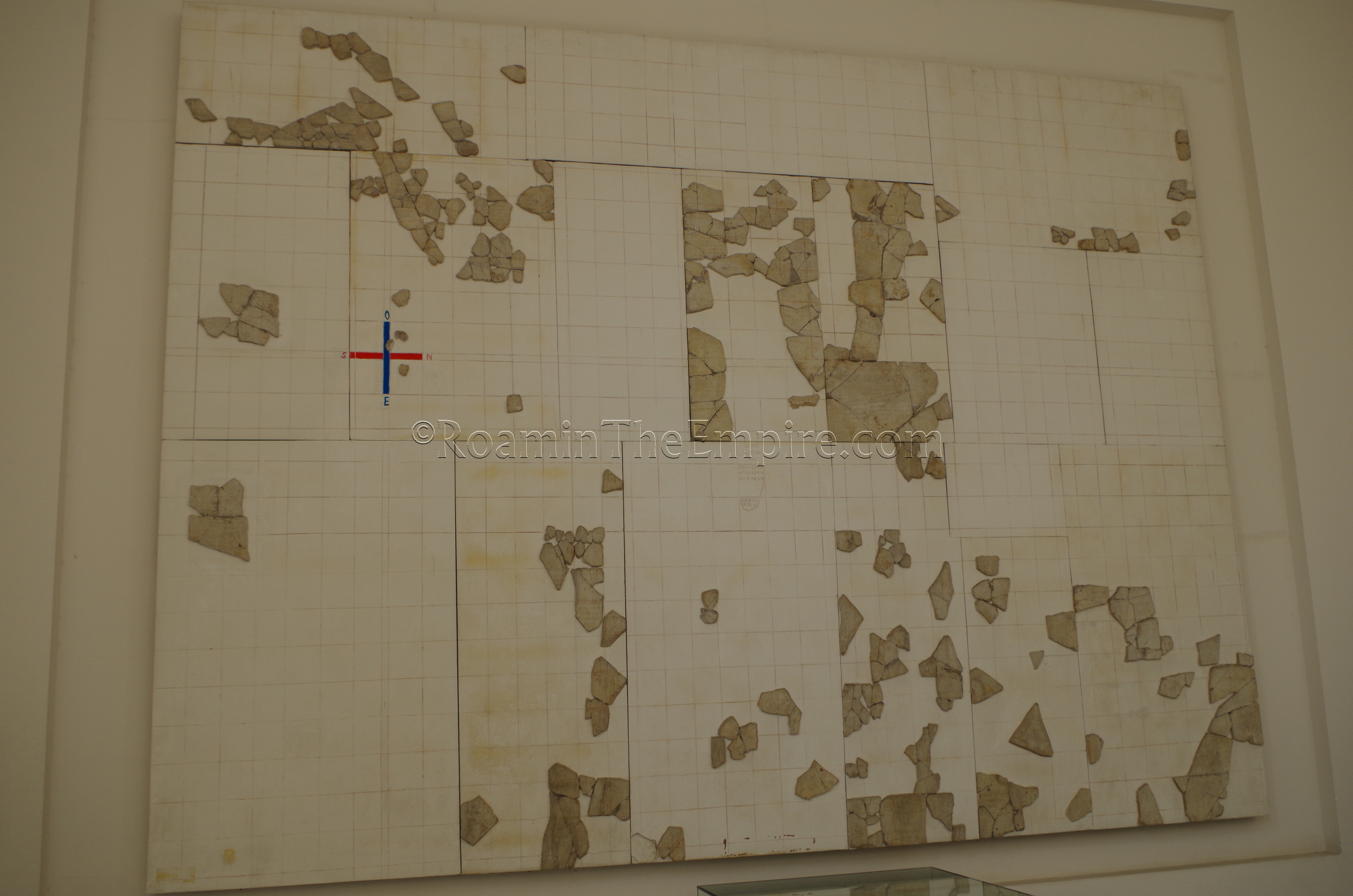
I was honestly a little underwhelmed by the Musée d’Art et d’Histoire d’Orange; I had budgeted about an hour and a half to visit it, thinking that with monuments like the arch and theater, there would be a pretty rich archaeological heritage to display here. In practice, I only spent less than a half an hour in the museum, and that was milking time a bit. The archaeological collection consists of two rooms, one with just a few artifacts in it. There are some reliefs from the theater, a few fragments of statues, a mosaic, and some smaller objects. The highlight of the collection are the three fragmentary cadastres dating to around the reign of Vespasian, which show land ownership and division in the area around Arausio. They are quite fragmentary, but nonetheless are also quite uncommon and a bit of a treat to see. There is also a tax registry tablet on display. There’s not much in the way of information, though there is an English explanation of the use of the cadastres, and most objects have at least a French identification and sometimes a short description in French. Given that it’s right across the street from the theater and essentially included in admission, there’s no reason not to stop and see the museum. The cadastres are quite interesting, but given the nature of the monuments in Orange, it didn’t quite live up to the expectations I had for it.
Other Sites
On the north face of Saint-Eutrope Hill overlooking the theater, there are supposed to be the remains of the capitolium visible. I, however, tried several routes to get up the hill from the north side, only to be repeatedly met by gates or signs forbidding use of the paths the rest of the way up the hill. There is a road up and a public park on the south approach to that area, quite a way from the north side, but given that the remains of the capitolium were only theoretically visible and access to that entire north face may have been limited even approaching from the south, I opted not to make that much of a detour.
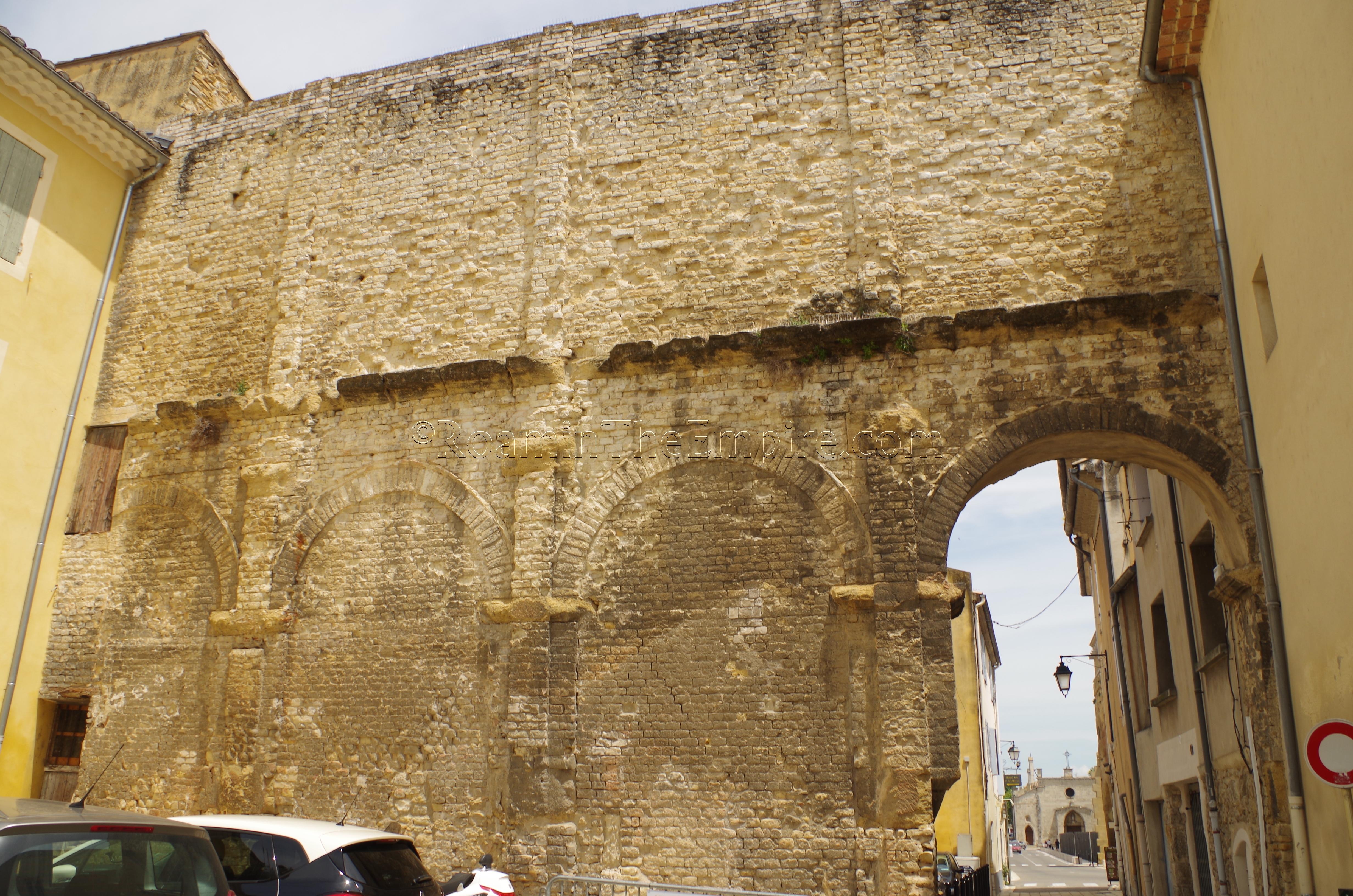
Just to the west of the museum, on Rue Pontillac are the remains of a 16 meter high wall of some indeterminate use. It is thought that it could perhaps be associated with the imperial cult district of the hemicycle complex area located next to the theater. It is alternatively described as being part of the western portico of the forum area. Walled in arcades on both the lower and upper registers of the wall are visible, and there is a small informational sign present on the east side of the wall, which can be passed through via one of the arcades.
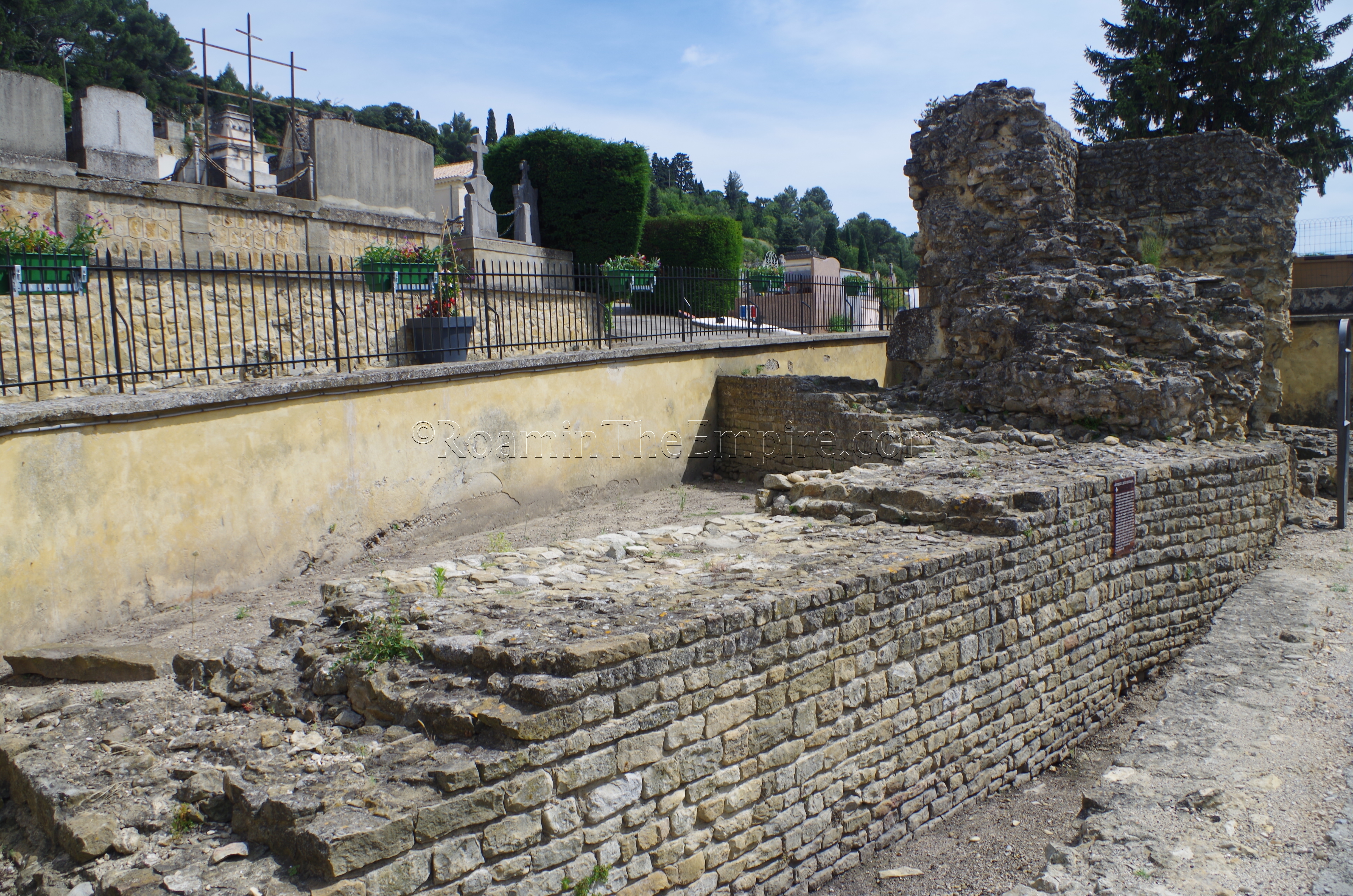
The last bit of Arausio that can be viewed is about a half a kilometer walk from the theater southwest down Rue Saint-Clément. Located here, at approximately Rue Saint-Clément 209, is a small stretch of wall and one of the towers of a gate in the city wall. These walls seem to date to the Augustan period and were also used in post-Roman defenses of the city. There is a small informational sign in French attached to the wall.
Orange is well worth the visit for the triumphal arch and theater, and is perfect for a half a day visit. All told, I only spent 2 and a half hours there, and if pressed for time, probably could have wrapped things up in about two hours.
Sources:
Bromwich, James. The Roman Remains of Southern France: A Guidebook. London: Routledge, 1996.
Livy, Ab Urbe Condita, 67.
Stillwell, Richard, William L. MacDonald, and Marian Holland. McAllister. The Princeton Encyclopedia of Classical Sites. Princeton, NJ: Princeton U Press, 1976.
Strabo, Geographica, 4.11.


